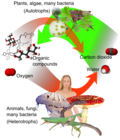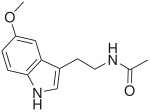Phototrophs (from Ancient Greek φῶς, φωτός (phôs, phōtós) 'light' and τροφή (trophḗ) 'nourishment') are organisms that carry out photon capture to produce...
8 KB (737 words) - 01:11, 6 August 2023
metabolism Nutritional type Source of energy Source of carbon Examples Phototrophs Sunlight Organic compounds (photoheterotrophs) or carbon fixation (photoautotrophs)...
143 KB (15,531 words) - 19:34, 31 July 2024
Some cyanobacteria are also capable of nitrogen fixation. These are phototrophs, which carry out photosynthesis. Like other nitrogen-fixing bacteria...
63 KB (6,905 words) - 18:22, 6 May 2024
Chloroflexota (redirect from Filamentous anoxygenic phototrophs)
thermophiles, which use oxygen and grow well in high temperatures; anoxygenic phototrophs, which use light for photosynthesis (green non-sulfur bacteria); and...
38 KB (2,640 words) - 04:50, 23 February 2024
RuBisCO is thought to be the single most abundant protein on Earth. Phototrophs use the products of their photosynthesis as internal food sources and...
112 KB (13,005 words) - 17:55, 3 August 2024
Global oceanic and terrestrial phototroph abundance, from September 1997 to August 2000. As an estimate of autotroph biomass, it is only a rough indicator...
47 KB (5,438 words) - 21:31, 24 July 2024
Organotrophs Photoheterotrophs Photosynthesis Photosynthetic efficiency Phototrophs Primary nutritional groups Primary production Consumers Apex predator...
128 KB (13,126 words) - 20:23, 10 August 2024
hydrogen sulfide. The primary producers can convert the energy in the light (phototroph and photoautotroph) or the energy in inorganic chemical compounds (chemotrophs...
19 KB (2,043 words) - 08:28, 7 July 2024
inorganic (chemolithotrophs). The chemotroph designation is in contrast to phototrophs, which use photons. Chemotrophs can be either autotrophic or heterotrophic...
9 KB (829 words) - 02:51, 16 May 2024
different heterotrophs is by assigning them as chemotrophs or phototrophs. Phototrophs utilize light to obtain energy and carry out metabolic processes...
28 KB (2,953 words) - 09:42, 6 August 2024
= light, hetero = (an)other, troph = nourishment) are heterotrophic phototrophs—that is, they are organisms that use light for energy, but cannot use...
20 KB (2,132 words) - 19:24, 30 July 2024
Other groups of archaea use sunlight as a source of energy (they are phototrophs), but oxygen–generating photosynthesis does not occur in any of these...
156 KB (16,493 words) - 15:57, 9 August 2024
PMID 22826715. Hardeland R (February 2015). "Melatonin in plants and other phototrophs: advances and gaps concerning the diversity of functions". Journal of...
66 KB (7,076 words) - 02:57, 12 August 2024
by organotrophs, while lithotrophs use inorganic substrates. Whereas phototrophs convert sunlight to chemical energy, chemotrophs depend on redox reactions...
113 KB (12,400 words) - 02:36, 5 August 2024
photosynthetic pigment, bacteriochlorophyll g and are the only known Gram-positive phototroph. They are a key player in symbiotic nitrogen fixation alongside plants...
11 KB (947 words) - 04:39, 27 July 2024
seen in dinoflagellates: phototrophy, mixotrophy, and heterotrophy. Phototrophs can be photoautotrophs or auxotrophs. Mixotrophic dinoflagellates are...
96 KB (10,320 words) - 21:44, 13 August 2024
(August 2019). "The trouble with oxygen: The ecophysiology of extant phototrophs and implications for the evolution of oxygenic photosynthesis". Free...
109 KB (11,776 words) - 19:45, 6 August 2024
Ochromonas tuberculata may invade and suppress specialist phago- and phototroph plankton communities depending on nutrient conditions". Oecologia. 148...
77 KB (7,092 words) - 10:23, 2 June 2024
community. Aerobic anoxygenic phototrophic bacteria are photoheterotrophic (phototroph) microbes that exist in a variety of aquatic environments. Most are obligately...
14 KB (1,842 words) - 12:27, 13 September 2023
reproduction is through isogamy, anisogamy or oogamy. Most species are obligate phototrophs but C. reinhardtii and C. dysostosis are facultative heterotrophs that...
10 KB (1,060 words) - 12:03, 20 July 2024
of distribution, lithotrophs may actually outnumber organotrophs and phototrophs in our biosphere. The use of inorganic electron donors such as hydrogen...
33 KB (4,063 words) - 11:38, 13 July 2024
in a MBR Argumentum ad populum, a logical fallacy Aerobic anoxygenic phototroph, a metabolic classification of bacteria Search for "aap" on Wikipedia...
3 KB (350 words) - 19:21, 8 July 2024
heterotrophs and autotrophs, including some plankton and carnivorous plants. Phototrophs obtain energy from light, while chemotrophs obtain energy by consuming...
36 KB (4,031 words) - 07:45, 25 July 2024
filamentous anoxygenic phototrophic bacteria (FAP), as the order contains phototrophs that do not produce oxygen. These bacteria are facultative aerobic. They...
7 KB (490 words) - 13:16, 16 November 2023
phycobilisomes. Prochlorococcus is the only known wild-type oxygenic phototroph that does not contain Chl a as a major photosynthetic pigment, and is...
37 KB (3,719 words) - 16:34, 4 June 2024
now phylum Cyanobacteria) and class Anoxyphotobacteriae (anaerobic phototrophs, orders: Rhodospirillales and Chlorobiales Scotobacteria (non-photosynthetic...
22 KB (2,881 words) - 17:32, 2 August 2024
castenholzii is a heterotrophic, thermophilic, filamentous anoxygenetic phototroph (FAP) bacterium. This species is in one of two genera of FAPs that lack...
8 KB (889 words) - 14:03, 14 December 2023
part) and purple non-sulfur bacteria. Purple bacteria are anoxygenic phototrophs widely spread in nature, but especially in aquatic environments, where...
30 KB (3,674 words) - 18:12, 8 August 2024
PMC 3566065. PMID 23405255. Gallon JR (1 March 2001). "N2 fixation in phototrophs: adaptation to a specialized way of life". Plant and Soil. 230 (1): 39–48...
47 KB (4,976 words) - 19:05, 17 July 2024
Chikaraishi Y., Kawato M., Takishita K. et al. (2012). "Algivore or Phototroph? Plakobranchus ocellatus (Gastropoda) Continuously Acquires Kleptoplasts...
6 KB (446 words) - 11:24, 31 July 2024


















